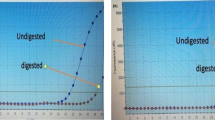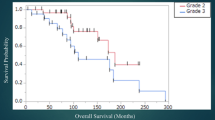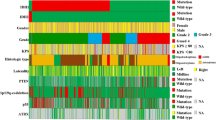Abstract
Background
The discovery of isocitrate dehydrogenase 1 and 2 gene (IDH1/2) mutations has enabled grade III glioma to be divided into mutated and wild-type IDH1/2 groups, which are known to carry different prognosis and molecular features. However, detailed subgroup analysis of grade III glioma is limited. To address this, we investigated molecular and prognostic features of grade III glioma with and without IDH1/2 mutation.
Methods
We retrospectively analyzed 115 grade III glioma patients. Clinical parameters were obtained from medical records. The mutation of IDH1/2 and TP53 was analyzed by direct sequencing. O6-methylguanine methyltransferase gene (MGMT) gene promoter methylation status was determined by methylation-specific polymerase chain reaction. Detection of chromosome copy number changes of 1p, 7p (EGFR), 9p (CDKN2A), 10q (PTEN), and 19q was carried out by multiple ligation-dependent probe amplification. Patients were divided into two groups, mutated IDH1/2 and wild-type IDH1/2, for correlation with the factors analyzed.
Results
In our series, as previously reported, IDH1/2 mutation was an independent prognostic marker for improved progression-free and overall survival (OS) (P < 0.0001 and P < 0.0001, respectively) in patients with grade III gliomas. Subgroup analysis found that incomplete resection, 7p gain, and TP53 mutation were independent prognostic factors of poor outcome in grade III glioma patients with mutated IDH1/2 (P = 0.0092, P = 0.015 and P = 0.026, respectively), while there were none in patients with wild-type IDH1/2.
Conclusions
IDH1/2 gene status was significantly associated with prognosis in grade III gliomas. Subgroup analysis found that poor prognostic factors existed even in patients with IDH1/2 mutation.


Similar content being viewed by others
References
Balss J, Meyer J, Mueller W et al (2008) Analysis of the IDH1 codon 132 mutation in brain tumors. Acta Neuropathol 116(6):597–602
Parsons DW, Jones S, Zhang X et al (2008) An integrated genomic analysis of human glioblastoma multiforme. Science 321(5897):1807–1812
Yan H, Parsons DW, Jin G et al (2009) IDH1 and IDH2 mutations in gliomas. N Engl J Med 360(8):765–773
Watanabe T, Nobusawa S, Kleihues P et al (2009) IDH1 mutations are early events in the development of astrocytomas and oligodendrogliomas. Am J Pathol 174(4):1149–1153
Ohgaki H, Kleihues P (2009) Genetic alterations and signaling pathways in the evolution of gliomas. Cancer Sci 100(12):2235–2241
Yan H, Bigner DD, Velculescu V et al (2009) Mutant metabolic enzymes are at the origin of gliomas. Cancer Res 69(24):9157–9159
van den Bent MJ, Dubbink HJ, Marie Y et al (2010) IDH1 and IDH2 mutations are prognostic but not predictive for outcome in anaplastic oligodendroglial tumors: a report of the European Organization for Research and Treatment of Cancer Brain Tumor Group. Clin Cancer Res 16(5):1597–1604
Ichimura K, Pearson DM, Kocialkowski S et al (2009) IDH1 mutations are present in the majority of common adult gliomas but rare in primary glioblastomas. Neuro Oncol 11(4):341–347
Levin VA, Hess KR, Choucair A et al (2003) Phase III randomized study of postradiotherapy chemotherapy with combination alpha-difluoromethylornithine-PCV versus PCV for anaplastic gliomas. Clin Cancer Res 9(3):981–990
van den Bent MJ, Carpentier AF, Brandes AA et al (2006) Adjuvant procarbazine, lomustine, and vincristine improves progression-free survival but not overall survival in newly diagnosed anaplastic oligodendrogliomas and oligoastrocytomas: a randomized European Organisation for Research and Treatment of Cancer phase III trial. J Clin Oncol 24(18):2715–2722
Sanson M, Marie Y, Paris S et al (2009) Isocitrate dehydrogenase 1 codon 132 mutation is an important prognostic biomarker in gliomas. J Clin Oncol 27(25):4150–4154
Houillier C, Mokhtari K, Carpentier C et al (2010) Chromosome 9p and 10q losses predict unfavorable outcome in low-grade gliomas. Neuro Oncol 12(1):2–6
Sonoda Y, Kumabe T, Nakamura T et al (2009) Analysis of IDH1 and IDH2 mutations in Japanese glioma patients. Cancer Sci 100(10):1996–1998
Mashiyama S, Murakami Y, Yoshimoto T et al (1991) Detection of p53 gene mutations in human brain tumors by single-strand conformation polymorphism analysis of polymerase chain reaction products. Oncogene 6(8):1313–1318
Sonoda Y, Kumabe T, Watanabe M et al (2009) Long-term survivors of glioblastoma: clinical features and molecular analysis. Acta Neurochir (Wien) 151(11):1349–1358
Sonoda Y, Yokosawa M, Saito R, et al (2010) O(6)-Methylguanine DNA methyltransferase determined by promoter hypermethylation and immunohistochemical expression is correlated with progression-free survival in patients with glioblastoma. Int J Clin Oncol 15:352–358
Wick W, Hartmann C, Engel C et al (2009) NOA-04 randomized phase III trial of sequential radiochemotherapy of anaplastic glioma with procarbazine, lomustine, and vincristine or temozolomide. J Clin Oncol 27(35):5874–5880
Jeuken J, Sijben A, Alenda C et al (2009) Robust detection of EGFR copy number changes and EGFR variant III: technical aspects and relevance for glioma diagnostics. Brain Pathol 19(4):661–671
Jeuken J, Cornelissen S, Boots-Sprenger S et al (2006) Multiplex ligation-dependent probe amplification: a diagnostic tool for simultaneous identification of different genetic markers in glial tumors. J Mol Diagn 8(4):433–443
Jeuken JW, Cornelissen SJ, Vriezen M et al (2007) MS-MLPA: an attractive alternative laboratory assay for robust, reliable, and semiquantitative detection of MGMT promoter hypermethylation in gliomas. Lab Invest 87(10):1055–1065
Kato H, Kato S, Kumabe T et al (2000) Functional evaluation of p53 and PTEN gene mutations in gliomas. Clin Cancer Res 6(10):3937–3943
Kanamori M, Kumabe T, Sonoda Y et al (2009) Predictive factors for overall and progression-free survival, and dissemination in oligodendroglial tumors. J Neurooncol 93(2):219–228
Ohgaki H, Kleihues P (2005) Population-based studies on incidence, survival rates, and genetic alterations in astrocytic and oligodendroglial gliomas. J Neuropathol Exp Neurol 64(6):479–489
Smith JS, Tachibana I, Passe SM et al (2001) PTEN mutation, EGFR amplification, and outcome in patients with anaplastic astrocytoma and glioblastoma multiforme. J Natl Cancer Inst 93(16):1246–1256
Dehais C, Laigle-Donadey F, Marie Y et al (2006) Prognostic stratification of patients with anaplastic gliomas according to genetic profile. Cancer 107(8):1891–1897
Etienne MC, Formento JL, Lebrun-Frenay C et al (1998) Epidermal growth factor receptor and labeling index are independent prognostic factors in glial tumor outcome. Clin Cancer Res 4(10):2383–2390
Zhou YH, Tan F, Hess KR et al (2003) The expression of PAX6, PTEN, vascular endothelial growth factor, and epidermal growth factor receptor in gliomas: relationship to tumor grade and survival. Clin Cancer Res 9(9):3369–3375
Hartmann C, Meyer J, Balss J et al (2009) Type and frequency of IDH1 and IDH2 mutations are related to astrocytic and oligodendroglial differentiation and age: a study of 1,010 diffuse gliomas. Acta Neuropathol 118(4):469–474
Weller M, Felsberg J, Hartmann C et al (2009) Molecular predictors of progression-free and overall survival in patients with newly diagnosed glioblastoma: a prospective translational study of the German Glioma Network. J Clin Oncol 27(34):5743–5750
Ohgaki H, Dessen P, Jourde B et al (2004) Genetic pathways to glioblastoma: a population-based study. Cancer Res 64(19):6892–6899
Ueki K, Ono Y, Henson JW et al (1996) CDKN2/p16 or RB alterations occur in the majority of glioblastomas and are inversely correlated. Cancer Res 56(1):150–153
Gan HK, Kaye AH, Luwor RB (2009) The EGFRvIII variant in glioblastoma multiforme. J Clin Neurosci 16(6):748–754
Aldape KD, Ballman K, Furth A et al (2004) Immunohistochemical detection of EGFRvIII in high malignancy grade astrocytomas and evaluation of prognostic significance. J Neuropathol Exp Neurol 63(7):700–707
Acknowledgments
This work was supported in part by Grants-in-Aid for Cancer Research from the Ministry of Health and Welfare in Japan to T. T. We thank T. Matsuki and M. Fue for assistance in extracting genomic DNA and PCR analysis.
Conflict of interest
There is no conflict of interest to declare.
Author information
Authors and Affiliations
Corresponding author
Electronic supplementary material
Below is the link to the electronic supplementary material.
Supplementary Fig. 1: Overall survival of patients with grade III gliomas based on either MGMT gene promoter status or chromosome 1p19q status with and without IDH1/2 mutation. In all univariate analyses, IDH1/2 mutation subgroups presented longer survival with statistical significance except for 1p19q codeletion with IDH1/2 mutation.
About this article
Cite this article
Shibahara, I., Sonoda, Y., Kanamori, M. et al. IDH1/2 gene status defines the prognosis and molecular profiles in patients with grade III gliomas. Int J Clin Oncol 17, 551–561 (2012). https://doi.org/10.1007/s10147-011-0323-2
Received:
Accepted:
Published:
Issue Date:
DOI: https://doi.org/10.1007/s10147-011-0323-2




